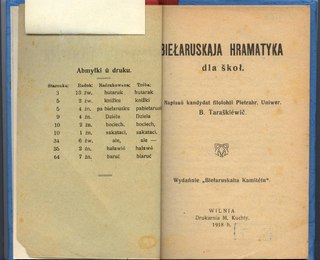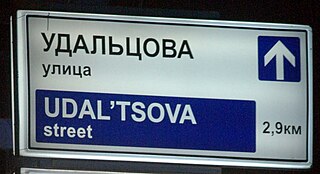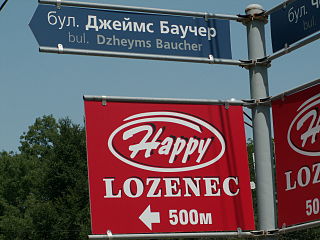
Instruction on transliteration of Belarusian geographical names with letters of Latin script is an official standard of Romanization of Belarusian geographical names.

Instruction on transliteration of Belarusian geographical names with letters of Latin script is an official standard of Romanization of Belarusian geographical names.
The instruction was adopted by a decree of the Belarusian State Committee on Land Resources, Geodetics and Cartography (2000-11-23). The official name of the document is: Russian : «Инструкция по транслитерации географических названий Республики Беларусь буквами латинского алфавита». The document had been published in the National registry of the judicial acts of the Republic Belarus (issue №3, 2001-01-11).
It is reported in the press that since October 2006 this instruction is recommended [1] for use by the Working Group on Romanization Systems of the United Nations Group of Experts on Geographical Names (UNGEGN). [2] The final decision of the UN was planned for a 2007 conference.
The system was modified again on 11 June 2007, mainly in order to conform with the recommendations of the UN WGRS, which advise avoiding the use of digraphs if possible, and adopted by the UN in version 3.0 of their romanization report, 17 March 2008. [3] The transliteration standard is based on the traditional Belarusian Latin alphabet (Łacinka). [4]
In February 2013 the system was recommended for adoption as the international system for the romanization of Belarusian geographical names. [4] [5]
The instruction replaces the previous equivalent regulations and sets up the rules of the rendering of the Belarusian geographical names, which are mandatory on the territory of the Republic of Belarus, when producing the cartographic and other (equivalent?) goods, destined for the international use.
Three diacritical signs are used:
| Cyrillic | Romanization | Special provision | Examples |
|---|---|---|---|
| А а | A а | - | Аршанскi - Aršanski |
| Б б | B b | - | Бешанковiчы - Biešankovičy |
| В в | V v | - | Вiцебск - Viciebsk |
| Г г | H h | - | Гомель - Homieĺ, Гаўя - Наŭjа |
| Д д | D d | - | Добруш - Dobruš |
| Е е | Je je | In the beginning of the word, after the vowels or the apostrophe or the separating soft sign or the Ўў/Ŭŭ. | Ельск - Jеĺsk, Бабаедава - Babajedava |
| iе | After the consonants. | Лепель - Liepieĺ | |
| Ё ё | Jo jo | In the beginning of the word, after the vowels or the apostrophe or the separating soft sign or the Ўў/Ŭŭ. | Ёды - Jody, Вераб’ёвiчы - Vierabjovičy |
| io | After the consonants. | Мёры - Miory | |
| Ж ж | Ž ž | - | Жодзiшкi - Žodziški |
| З з | Z z | - | Зэльва - Zeĺva |
| І і | I i | - | Iванава - Ivanava, Iўе - Iŭje |
| Й й | J j | - | Лагойск - Lahojsk |
| К к | K k | - | Круглае - Kruhlaje |
| Л л | L l | - | Любань - Liubań |
| М м | M m | - | Магiлёў - Mahilioŭ |
| Н н | N n | - | Нясвiж - Niasviž |
| О о | O o | - | Орша - Orša |
| П п | P p | - | Паставы - Pastavy |
| Р р | R r | - | Рагачоў - Rahačoŭ |
| С с | S s | - | Светлагорск - Svietlahorsk |
| Т т | T t | - | Талачын - Talačyn |
| У у | U u | - | Узда - Uzda |
| Ў ў | Ŭ ŭ | - | Шаркаўшчына - Šarkaŭščyna |
| Ф ф | F f | - | Фанiпаль - Fanipaĺ |
| Х х | Ch ch | - | Хоцiмск - Chocimsk |
| Ц ц | C c | - | Цёмны Лес - Ciоmny Lies |
| Ч ч | Č č | - | Чавусы - Čavusy |
| Ш ш | Š š | - | Шумiлiна - Šumilina |
| ’(apostrophe) | - | Not transliterated. | Раз’езд - Razjezd |
| Ы ы | Y y | - | Чыгiрынка - Čyhirynka |
| Ь ь | ´ (acute accent) | Combining acute. | дзь = dź, зь = ź, ль = ĺ, нь = ń, сь = ś, ць = ć. Example: Чэрвень - Červień |
| Э э | E e | - | Чачэрск - Čačersk |
| Ю ю | Ju ju | In the beginning of the word, after the vowels or the apostrophe or the separating soft sign or the Ўў/Ŭŭ. | Юхнаўка - Juchnaŭka, Гаюцiна - Hajucina |
| iu | After the consonants. | Любонiчы - Liuboničy | |
| Я я | Ja ja | In the beginning of the word, after the vowels or the apostrophe or the separating soft sign or the Ўў/Ŭŭ. | Ямнае - Jamnaje, Баяры - Bajary |
| iа | After the consonants. | Вязынка - Viazynka, Bаляр’яны - Valiarjany |
Note: The initial 2000 version differed from the above: ў = ú, ь = ’ (apostrophe; e.g., дзь = dz’, зь = z’, ль = l’, нь = n’, сь = s’, ць = c’).
Transliteration is a type of conversion of a text from one script to another that involves swapping letters in predictable ways, such as Greek ⟨α⟩ → ⟨a⟩, Cyrillic ⟨д⟩ → ⟨d⟩, Greek ⟨χ⟩ → the digraph ⟨ch⟩, Armenian ⟨ն⟩ → ⟨n⟩ or Latin ⟨æ⟩ → ⟨ae⟩.
Devanagari is an Indic script used for many Indo-Aryan languages of North India and Nepal, including Hindi, Marathi and Nepali, which was the script used to write Classical Sanskrit. There are several somewhat similar methods of transliteration from Devanagari to the Roman script, including the influential and lossless IAST notation. Romanized Devanagari is also called Romanagari.

Svietlahorsk or Svetlogorsk, known as Shatsilki until 1961, is a town in Gomel Region, Belarus. It serves as the administrative center of Svietlahorsk District. It is situated on the Berezina River and has 67,054 inhabitants.

The Belarusian Latin alphabet or Łacinka for the Latin script in general is the common name for writing Belarusian using Latin script. It is similar to the Sorbian alphabet and incorporates features of the Polish and Czech alphabets. Today, Belarusian most commonly uses the Cyrillic alphabet.

The romanization of the Russian language, aside from its primary use for including Russian names and words in text written in a Latin alphabet, is also essential for computer users to input Russian text who either do not have a keyboard or word processor set up for inputting Cyrillic, or else are not capable of typing rapidly using a native Russian keyboard layout (JCUKEN). In the latter case, they would type using a system of transliteration fitted for their keyboard layout, such as for English QWERTY keyboards, and then use an automated tool to convert the text into Cyrillic.
ISO 15919 is one of a series of international standards for romanization by the International Organization for Standardization. It was published in 2001 and uses diacritics to map the much larger set of consonants and vowels in Brahmic and Nastaliq scripts to the Latin script.
The romanization of Ukrainian, or Latinization of Ukrainian, is the representation of the Ukrainian language in Latin letters. Ukrainian is natively written in its own Ukrainian alphabet, which is based on the Cyrillic script. Romanization may be employed to represent Ukrainian text or pronunciation for non-Ukrainian readers, on computer systems that cannot reproduce Cyrillic characters, or for typists who are not familiar with the Ukrainian keyboard layout. Methods of romanization include transliteration and transcription.
A raion is a type of administrative unit of several post-Soviet states. The term is used for both a type of subnational entity and a division of a city. The word is from the French rayon, and is commonly translated as "district" in English.

The United Nations Statistical Commission (StatCom) is a Functional Commission of the United Nations Economic and Social Council, established in 1947. The Statistical Commission oversees the work of the United Nations Statistics Division (UNSD). Its 24 member states are elected by the Economic and Social Council on the basis of the following geographical distribution: African states (5), Asian States (4), Eastern European States (4), Latin American and Caribbean States (4), Western European and other States (7). Since July 1999 the Commission meets every year. As set forth by the Economic and Social Council, in the terms of reference, the Commission shall assist the Council:

Romanization of Bulgarian is the practice of transliteration of text in Bulgarian from its conventional Cyrillic orthography into the Latin alphabet. Romanization can be used for various purposes, such as rendering of proper names and place names in foreign-language contexts, or for informal writing of Bulgarian in environments where Cyrillic is not easily available. Official use of romanization by Bulgarian authorities is found, for instance, in identity documents and in road signage. Several different standards of transliteration exist, one of which was chosen and made mandatory for common use by the Bulgarian authorities in a law of 2009.

The Ukrainian Latin alphabet is the form of the Latin script used for writing, transliteration and retransliteration of Ukrainian.
The Kyrgyz language is written in the Kyrgyz alphabet, a modification of Cyrillic. There is no commonly accepted system of romanization for Kyrgyz, i.e. a rendering of Kyrgyz in the Latin alphabet. For geographic names, the Kyrgyz government adopted the BGN/PCGN romanization system. There have been periodic discussions about changing the country's official writing system to Latin script. These proposals have seen little progress as the Cyrillic alphabet is more firmly established in Kyrgyzstan than in other post-Soviet Turkic states, which have either successfully switched to Latin script or are in active transition. Some Kyrgyz romanization systems are given below:
Romanization or Latinization of Belarusian is any system for transliterating written Belarusian from Cyrillic to the Latin alphabet.
GOST 16876-71 is a romanization system devised by the National Administration for Geodesy and Cartography of the Soviet Union. It is based on the scientific transliteration system used in linguistics. GOST was an international standard so it included provision for a number of the languages of the Soviet Union. The standard was revised twice in 1973 and 1980 with minor changes.
The BGN/PCGN romanization system for Belarusian is a method for romanization of Cyrillic Belarusian texts, that is, their transliteration into the Latin alphabet.

A district or raion in Belarus is the second-level administrative division in the country which are subordinate to regions.
According to a 1998 law of the Republic of Belarus, there are three categories of urban-type settlements in Belarus:

The United Nations Group of Experts on Geographical Names (UNGEGN) is one of the nine expert groups of the United Nations Economic and Social Council (ECOSOC) and deals with the national and international standardization of geographical names. Every five years they hold the UNGEGN conference. The UNGEGN also publishes international guidelines.

Belarus–NATO relations refers to relations between the Republic of Belarus and the NATO for the sake of security, realization of common interests under the individual partnership program, participation in the "Planning and Analysis Process".